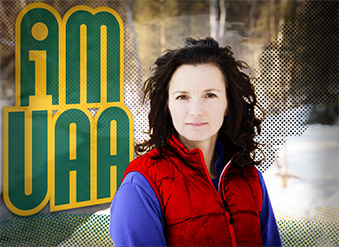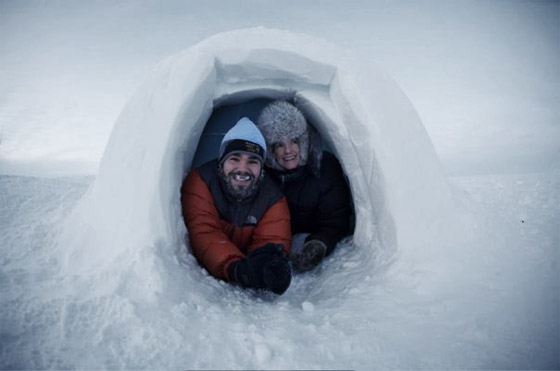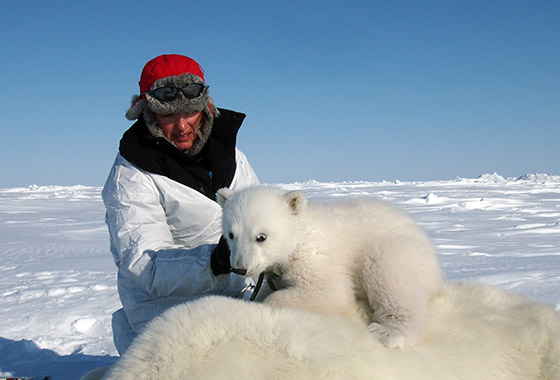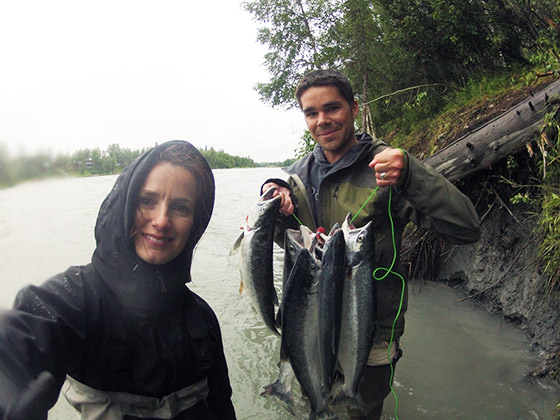Student Spotlight: Lily Peacock
by Green & Gold News |
 Lily Peacock
Lily Peacock
Alaska WWAMI School of Medical Education E'12
Hometown: Birmingham, United Kingdom
Fun Fact: She's a polar bear expert and spent four years in the remote Inuit village of Igloolik
in the territory of Nunavut, Canada, researching the territory's bear population
Lily Peacock's wildlife biologist colleagues were shocked when she announced her intent to leave her job as a polar bear researcher and return to the classroom to become a doctor.
"People said to me, 'You have the best job in the world-you work with polar bears and you're really successful at what you do," Lily says.
But she didn't decide to leave her job because she didn't like it; she wanted to do something different with her life. "I was in a job that I liked 95 percent of the time, but I want a job that I like 110 percent of the time," she says.
Academia is something very familiar to Lily, who holds a Ph.D. in Ecology, Evolution and Conservation Biology from the University of Nevada, Reno. Both of her parents are college professors, and their careers took the family all over the world during Lily's childhood-from her birth country of England, to Hong Kong, Australia, Canada, Oklahoma and eventually Michigan, where she graduated from high school.
Lily earned her undergraduate degree in biology from University of California, Berkeley, with a minor in Russian, before she embarked on her doctoral studies in Reno.
For her doctoral dissertation, Lily spent six years in Southeast Alaska studying black bear population ecology on Kuiu Island.
As Lily was preparing to accept her Ph.D., one of her professors received a phone call from a colleague who was doing polar bear research in Arctic Canada. He was leaving his post and needed to find a replacement. "He needed someone that was willing to go up to the middle of nowhere," she says. Lily's professor presented her with the opportunity, but she initially turned it down because her boyfriend, Steve, (who's now her husband) wasn't interested in moving to a remote community in the Arctic.
About a year after she accepted a teaching position, that same opportunity in Canada popped up again, and this time, Lily and her beau decided to accept the challenge and move north. The couple packed up and moved from Reno, Nevada, to the remote Inuit village of Igloolik, or "Place of Igloos," a small island off the northern tip of Baffin Island in the Canadian territory of Nunavut. Talk about a change of scenery.

"It was scary," Lily says. "There were so many unknowns. Villagers only spoke Inuktitut,
little English-there were a lot of things to figure out. But the people were very
warm and friendly, the work was amazing and I learned a lot-I loved it."
After four years of living and working in the Arctic, Lily learned about a polar bear
biologist job in Anchorage, Alaska, with the U.S. Geological Survey (USGS). She and
her husband decided it was time for a change and came to Alaska in 2009.
For three years Lily studied polar bears in the Southern Beaufort Sea. She led the USGS Alaska Science Center polar bear research program, which conducts long-term research on polar bears to inform local, state, national and international policy makers regarding conservation of the species and its habitat.

Though Lily loves working with polar bears, she had an itch to do something different with her life. "I sort of knew it wasn't a perfect match," she says, explaining how she got onto the path of wildlife biology in college. "It's been an exciting career; I've done it for a long time," she adds.
Her experience living and working in remote villages has magnified for her the desperate need of medical professionals among underserved populations. "It became very apparent to me that serving these populations would be a job I'd enjoy doing," she says. Already a scientist, Lily decided it was time to shift her focus to medicine.
To Lily, working in medicine is the perfect combination of mind and heart. "Doctors understand science, but they also show compassion," she says. "Compassion wasn't a part of my scientific work-that element is really appealing to me in a profession. In medicine, you can choose to make an impact every day with individual patients."
She decided to make the leap into a new career, but it wasn't easy. She knew she needed to study for the MCAT exam, which is, in and of itself, a major commitment. A couple months into studying, Lily was overwhelmed by work and the additional hours of studying. She took the advice of a good friend, who told her to ask to go part-time at work. "I would've never done this if my friend hadn't suggested it," Lily says.
Lily admits that it was difficult to approach her employer about going part-time and potentially changing careers. "At that point, I didn't know if I'd get into med school-what would happen if I didn't get in?" Though her colleagues were shocked at first, they've been fully supportive of Lily's decision.
"The hardest part of all this has been telling my colleagues, my mentors, who have helped me so much for all these years," Lily says. "I feel like I'm betraying them, but they've all been really supportive."
Lily cut down her work hours to 20 hours a week to support her new study schedule. Not surprisingly, she hit the books hard, passed the MCAT, applied for med school and got in.
"It was a big life change," Lily says, "but it was now or never. We cut our salary in half, sold our house on the hillside and moved into a small apartment-it's taken a lot of support from my husband."
But Lily has no regrets.
Unlike her 20-somethings classmates, Lily was 38 when she was accepted into medical school. She chose the Alaska WWAMI School of Medical Education for many reasons, mainly for its "Alaskan-ness." "Alaska feels like home to me," Lily says, "and it's really great to be in a cohort with fellow Alaskans-we're all from here." She also values the small class sizes and individualized attention from professors. "There's also the benefit of the connection to the world-class University of Washington School of Medicine. It's a really broad program and I like its regional focus."
Having traveled to villages across Southeast Alaska and the North Slope for her research, Lily has seen firsthand the unmet need for medical professionals in rural areas. "I knew I could have a bigger impact practicing medicine," she says, "and I'm the kind of person that enjoys working in these places."

The WWAMI program is structured so that students spend their first year at their home campus and their second year at the University of Washington School of Medical Education in Seattle. Cohorts from all the WWAMI states-Washington, Wyoming, Alaska, Montana and Idaho-gather in Seattle for their second year before embarking on their third and fourth year clinicals at various rural locations across the five-state region.
Though Lily is in transition between careers, she hasn't cut all ties with her former profession. She continues to mentor graduate students in Minnesota, California and Alberta, and is a research affiliate faculty member in UAA's Environment and Natural Resources Institute (ENRI). She also continues to work a few hours a week with USGS.
Lily works closely with UAA's Jeff Welker, biology professor and past director of ENRI, on collaborative research projects with multiple organizations across Alaska.
Her partnership with ENRI began during her tenure at USGS. She sat in on one of Welker's wildlife ecology courses, which introduced her to a specialized piece of equipment in the ENRI lab-a mass spectrometer-that could be useful for USGS. She explains that USGS was sending its tissue samples to Wyoming for processing, but this mass spectrometer in Welker's lab was just the piece of equipment USGS needed to analyze tissue samples locally.
For Lily's final polar bear research project, she is working with Welker and his students on a collaborative project with USGS and the North Slope Borough to analyze polar bear samples taken from areas across the state's northernmost region. The intent is to determine how many polar bears are eating from bowhead whale bone piles, which, Lily explains, are becoming problematic for Alaska's polar bear population.
"Before, whale hunters would dispose of carcasses on the sea ice, which would ultimately result in the remains falling to the bottom of the ocean," Lily explains. "But now, with less and less sea ice, whale remains are being thrown into trash heaps on land. Bears gather around these piles, which are changing some bears' movements and diet." She says these congregations have the potential to increase the spread of disease and cause human-bear conflicts.
"We take the blood and fur that we collect from the field to get an idea of what polar bears are eating," Lily says. "We can tell from the chemistry of their tissues if they're bowhead whale bone pile eaters or not." The research team has found that about 25 percent of the region's polar bears are eating from the bone piles.
Lily will button up this final research project this summer in preparation for the next phase of her medical education: year two at the University of Washington School of Medicine in Seattle. She's unsure of where years three and four will take her, but long term, Lily plans to work in family practice or OB-GYN in a small town, perhaps somewhere in Alaska.
One thing's for sure: any small town will be lucky to have Lily as its doc-she might even share some of her favorite polar bear adventures with her patients.
 "Student Spotlight: Lily Peacock" is licensed under a Creative Commons Attribution-NonCommercial 4.0 International License.
"Student Spotlight: Lily Peacock" is licensed under a Creative Commons Attribution-NonCommercial 4.0 International License.














